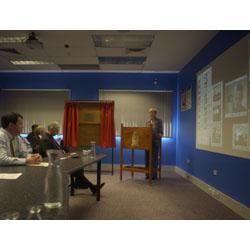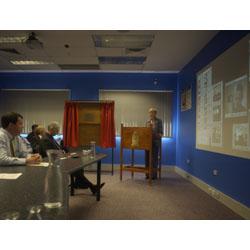Video wall example of access grid potential
Published on 05 August, 2003
A demonstration of CQU Rockhampton\'s new 6m x 1.5m video wall was the focus of a visit by Minister for Innovation and Information Economy Paul Lucas this week.
The video wall is an extension of videoconferencing via the internet. It enables participants from many locations to interact live, and they can be viewed in multiple displays on a single wall.
Minister Lucas was on campus to present a cheque for $2 million to the Queensland Parallel Supercomputer Foundation CEO, Professor Bernard Pailthorpe, as the final instalment of a $10 million three-year grant to boost the State\'s advanced computing and communications infrastructure.
 This funding has helped patch Rockhampton researchers into an advanced computing access grid (making the video wall possible). Gladstone\'s light metal and environmental researchers will be brought into the loop next month.
This funding has helped patch Rockhampton researchers into an advanced computing access grid (making the video wall possible). Gladstone\'s light metal and environmental researchers will be brought into the loop next month.
During the Minister\'s visit, participants at universities and institutions in Townsville, Sydney, Canberra and Brisbane could be heard and seen as they joined in the presentation live via the video wall.
The demonstration showed how the video wall could host shared work documents and complex displays including electron microscope scans and satellite images. This technology has also shown promise for dealing with public health and natural disaster emergencies, as well as collaborative research projects.
Much was made of its ability to save time and money by negating the need to bring conference participants together in the same location.
Vice-Chancellor Professor Glenice Hancock said the technology would give CQU researchers a new collaborative tool to work with colleagues across Australia and throughout the world.
\"Projects currently being investigated to provide online access to scientific instruments will expand our research endeavours,\" Professor Hancock said.
“This facility means that researchers in Rockhampton, Brisbane, Cairns, Townsville, Sydney and Canberra can all hook up to each other and see, collaborate and share data in real time,” Mr Lucas said.
Mr Lucas said Queensland’s expertise in access grid technology had recently been put to the test during the SARS outbreak in which many Taiwanese medical staff were quarantined within hospital wards.
“Scientists at QUT in Brisbane were able to respond to a call for help from Taiwan and provide advice on establishing videoconferencing facilities within hospitals to enable consultations, diagnoses, and no-contact family visits,” Mr Lucas said.
“This big screen, which will use ‘access grid’ technology that’s been funded by the State Government, can be split up to accommodate up to 23 individual screens at once – so you can have people at up to 23 sites watching and participating at the same time.” “What’s important about this type of technology is that it’s helping our researchers be even better and smarter at what they do.
Mr Lucas said Central Queensland University now joins James Cook University, Griffith University, Queensland University of Technology and the University of Queensland on the access grid, with the University of Southern Queensland to come soon.
 “This is a major breakthrough for Central Queensland, as it will help promote collaboration with other research organisations and industry,” Mr Lucas said.
“This is a major breakthrough for Central Queensland, as it will help promote collaboration with other research organisations and industry,” Mr Lucas said.
“Already this access grid technology is proving to be a valuable tool, with James Cook University using it to teach 28 hours of classes per week between Townsville and Cairns in subjects such as computer science, environmental science and earth sciences.
“The benefits are that it means less staff travel between sites, and the students prefer the high-quality presentation and real-time interaction provided by the access grid compared with other forms of video-conferencing.” Mr Lucas said the Australian Institute of Marine Science and the CRC Reef Research in Townsville were also interested in using grid technology.
“These organisations are interested, as it could help their researchers link up to scientists at the National Oceanic and Atmospheric Administration in the United States to manipulate and discuss coral reef images, models and data,” Mr Lucas said.
“This funding has enabled Queensland to develop the biggest concentration of access grids in the world, and is helping our researchers to undertake supercomputer-aided research in areas such as medical research, aquaculture, salinity, mining, manufacturing and environmental modelling,” Mr Lucas said.

